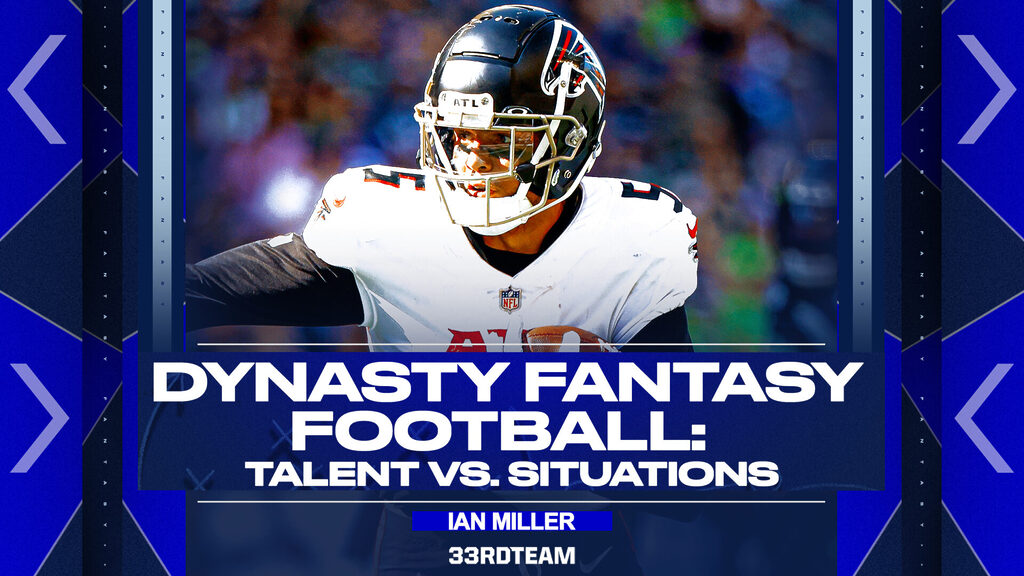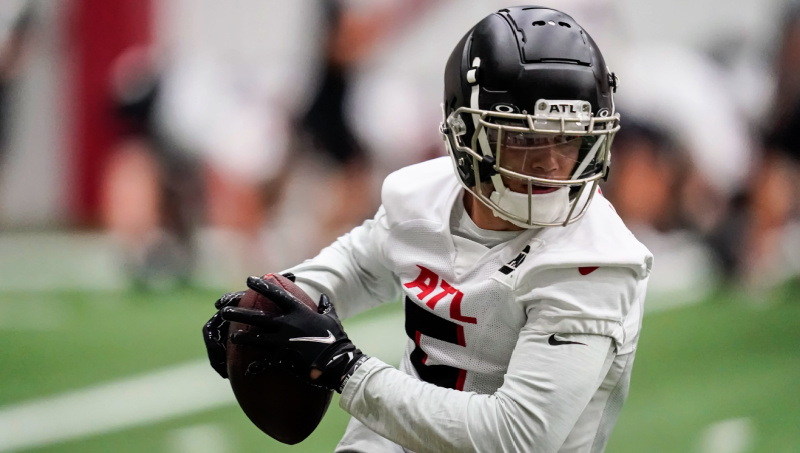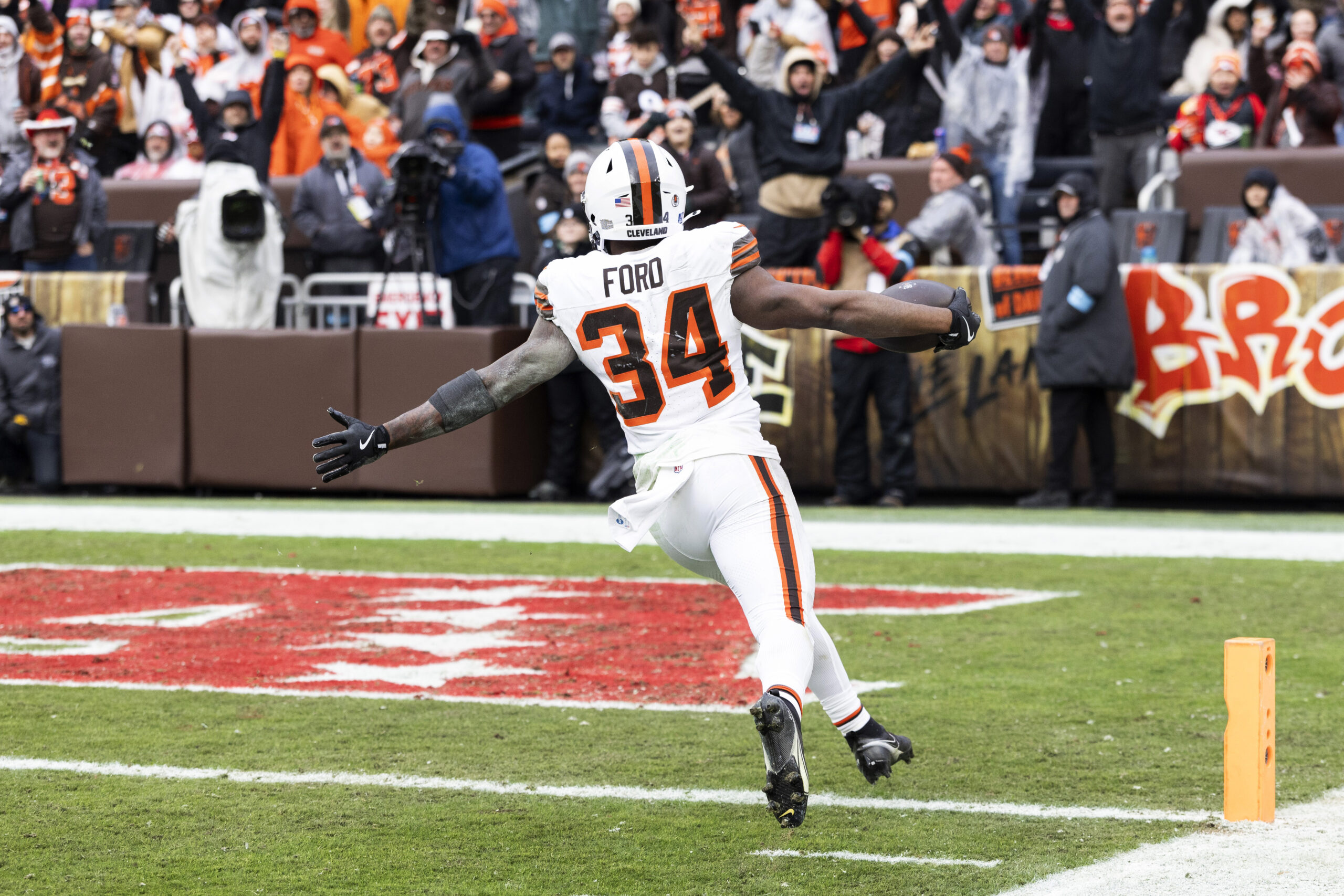Analysis
6/15/23
6 min read
Dynasty Fantasy Football: Taking a Closer Look at Talent vs. Situation

The phrase “talent vs. situation” is widespread across the fantasy football world. Most people understand it to mean comparing a player’s talent level to how it’s being supported by his team. Those people are right.
However, it’s more complex than just comparing talented players to the team they play for. There is a way we can use talent vs. situation to our advantage in dynasty, but we must define those terms.
Defining Talent, Situation
What makes a player talented? We start by using a player’s peripherals to determine their talent level. Peripherals are statistical metrics such as target share, yards per route run and other data points that help us isolate a player's talent level from their team situation. In other words, it helps compare players' talent levels from differing offenses.
Let’s take Drake London for example, whose 28.2 percent target share last season was the second-highest for a rookie ever and was the NFL's fifth-highest in 2022. His target share only trailed Ja’Marr Chase, Davante Adams, Cooper Kupp and Tyreek Hill. All of whom finished as top six receivers with 18.0+ PPG. So why, despite the fifth-highest target share in the entire league, did London's targets per game rank 40th, while his fantasy finish was WR45?
This is where the situation term comes into play. London's peripherals should’ve led to a much higher fantasy finish than WR45. So why did it not? Simple. The Atlanta Falcons.
There are two main data points we look at when deciphering a team situation: volume and efficiency. The Falcons were abysmal in both aspects. They finished with 24.4 pass attempts per game in London’s rookie season. If it wasn’t for the Chicago Bears posting a historically lower passing volume, the Falcons would’ve had the fewest team pass attempts since the 2005 Pittsburgh Steelers.
That’s a major reason why London can put up the fifth-highest target share and finish 40th in targets per game. If London played on a team that threw the ball at a league-average rate of 33.3 pass attempts per game, his targets per game would balloon from 40th to ninth. That’s ahead of CeeDee Lamb and Amon-Ra St. Brown.
Efficiency is the other main data point to consider when analyzing team situations. How often is your team’s offense scoring touchdowns? Between Marcus Mariota and Desmond Ridder throwing the ball for Atlanta, it finished just 17th in touchdown percentage with 4.1 percent.
That's not as abysmal as their passing volume, but pairing the 31st-highest team in pass attempts with the 17th-highest team in touchdown percentage creates a poor situation for London.
Determining Talent vs. Situation
So how do we articulate what we know about player talents and team situations to create an advantage in dynasty leagues? Every player is not treated the same when it comes to talent vs. situation. There is nuance to it. To show that off, we’ll analyze talent vs. situation from two subcategories: young players and veteran players.
Starting with young players, it’s much easier to base your dynasty evaluations on talent than on team situations. Because of how quickly situations change, the last thing you want to do is trade off a clearly talented young asset like London at a lower value. If his situation changes, it could allow for an upper-echelon fantasy finish that his peripherals are capable of.
In the past few seasons, the Buffalo Bills and Cincinnati Bengals have gone from afterthoughts as fantasy situations to some of the league’s best.
The Bills went from passing the ball at a below-league-average rate with poor efficiency to an unexpected Josh Allen breakout that now brings near-league-high passing volume and strong efficiency.
The season before Joe Burrow was drafted, the Bengals were 31st in passing touchdown percentage with 2.9 percent, but now they put up the fourth-highest passing touchdown percentage at 5.7 percent. It also comes off the sixth-highest passing volume in the league.
Team situations are far more unpredictable than a player’s talent level. If you give up on a young player with league-breaking peripherals because his situation is capping his fantasy production, you’re inevitably going to get burnt.
Veteran players are on the exact opposite side of the spectrum. While strong peripherals at must be present for us to initially like the player, their situation is the most important. When acquiring veteran players in dynasty, you do so with a short timeframe ahead, also known as immediate production.
So, if we take the London example but pretend he’s 30 years old instead of 22, he wouldn’t be nearly as much of a buy as he is. Of course not, he’s older. It's even more so because when you acquire a 30-year-old in dynasty, you need immediate production. You aren’t looking a couple of years ahead.
If the 30-year-old London's fifth-highest target share and 15th-highest yards per team pass attempt in the league is turning into WR45 production, there isn’t much intrigue because the situation doesn’t allow for high-end immediate production. This is why someone like Keenan Allen is a buy on the dynasty market. His peripherals show us he’s a talented player at 31, and his team situation with the Los Angeles Chargers allows for those peripherals to provide high-end immediate production.
Comparing how we view talent and situations for young players vs. veterans may seem obvious, but they're completely different. What both have in common is the need for talent.
Let’s take DJ Moore and Gabriel Davis. During the 2022 offseason, both were valued as top 25 wide receivers.
Moore proved he could earn targets at a high rate, coming off a 27.2 percent target share. He also had strong per-route peripherals to show he was quite good with his targets. Unfortunately, he played for the Carolina Panthers, who held one of the league's worst situations.
Davis never put up even a 12 percent target share or went above 1.00 yards per team pass attempt, but he was paired with Allen in one of the league’s best situations.
A year later, Buffalo is still one of the league’s best situations while Moore finds himself with Chicago in one of the league’s worst situations. Yet, Moore is valued as a top 25 wide receiver asset while Davis is outside of the top 45 wide receivers. How could this be?
Starting Fires
While the degree of importance for a player’s team situation will rise with age, what doesn’t change is talent is always needed first. You can start a fire with a lighter in the snow or dessert, either work. While one setting is going to make it much easier for the fire to start, you’ll never start the fire anywhere without the lighter.
Follow The 33rd Team Podcast Network on Spotify and Apple Podcasts.









